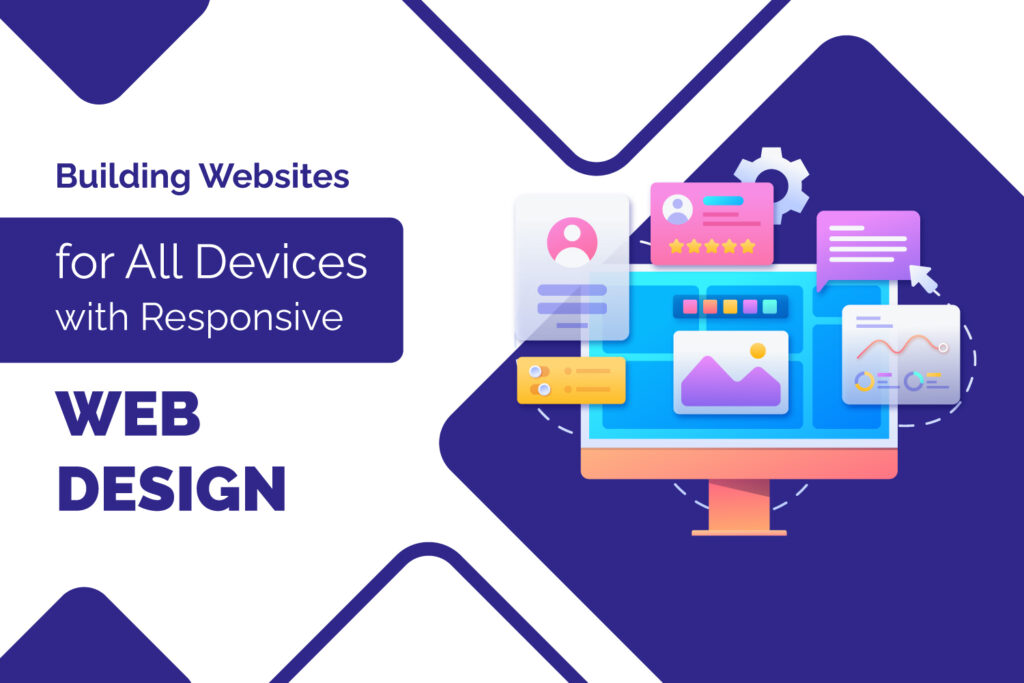Introduction of Responsive Web Design
In today’s digital era, where users access the internet across a myriad of devices, from smartphones to desktop computers, ensuring a seamless browsing experience is paramount. This is where responsive web design (RWD) comes into play. Not only is responsive web design becoming popular, but it’s essential. Let’s delve into what responsive web design entails and why it’s crucial for creating websites that cater to every device.
Understanding Responsive Web Design and Its Key Principles
Responsive web design (RWD) is a design approach aimed at creating websites that provide an optimal viewing experience across a wide range of devices and screen sizes. At its core, RWD relies on three key components: fluid grids, flexible images, and media queries.
Key Principles of Responsive Web Design:
1. Fluid Grids:
The foundation of responsive web design is fluid grids. Traditionally, web layouts were built using fixed-width layouts, which resulted in a static design that didn’t adapt well to different screen sizes. Fluid grids, on the other hand, use relative units such as percentages to define the widths of elements, allowing them to scale proportionally based on the user’s screen size.
For example, a container with a width set to 100% will always occupy the full width of its parent element, regardless of the screen size. This ensures that the layout remains flexible and adapts seamlessly to various devices, from smartphones to large desktop monitors.
2. Flexible Images:
In addition to fluid grids, responsive web design relies on flexible images to ensure that visual content scales appropriately across different screen resolutions and devices. By setting the maximum width of images to 100%, designers prevent images from exceeding the width of their containing elements, thus maintaining proper proportions and preventing horizontal scrolling on smaller screens.
Flexible images are achieved using CSS properties such as max-width: 100% and height: auto, which instruct the browser to scale images proportionally based on the available space while preserving their aspect ratio. This ensures that images remain sharp and clear across a variety of devices and screen densities.
3. Media Queries:
Media queries are CSS rules that allow designers to apply different styles to a web page based on various device characteristics, such as screen width, height, orientation, and resolution. Media queries enable designers to create adaptive layouts and customize the presentation of content for different viewing contexts.
For example, a media query might specify that certain styles should be applied only when the screen width is greater than a certain threshold, effectively targeting larger devices and desktop displays. By using media queries strategically, designers can create responsive designs that optimize the user experience across a wide range of devices and screen sizes.
Best Practices for Responsive Web Design:
1. Mobile-first Approach: Design with mobile devices in mind first, prioritizing essential content and functionality for smaller screens before scaling up for larger devices.
2. Viewport Meta Tag: Use the viewport meta tag to control the width and scaling of the viewport, ensuring consistent display across devices and preventing issues like zooming.
3. Flexible Grids and Layouts: Employ fluid grid systems and flexible layouts to allow content to adapt smoothly to different screen sizes and orientations.
4. Media Queries: Implement media queries to apply specific styles and layout changes based on device characteristics, optimizing the user experience across a range of devices.
5. Optimized Images and Media: Optimize images and media assets for fast loading times and optimal display on various devices, using techniques like compression and lazy loading.
6. Performance Optimization: Minimize HTTP requests, reduce server response times, and leverage caching techniques to improve website performance, particularly on mobile devices with limited bandwidth.
7. Testing and Debugging: Thoroughly test responsive designs across different devices, browsers, and screen sizes to identify and address any layout or functionality issues.
8. Accessibility Considerations: Ensure that your responsive design is accessible to all users, including those with disabilities, by adhering to web accessibility standards and guidelines.
9. Progressive Enhancement: Implement progressive enhancement to provide a baseline experience for all users, with advanced features and enhancements for devices that support them.
10. Continuous Iteration: Regularly review and update your responsive design based on user feedback, technological advancements, and changes in device capabilities to ensure ongoing effectiveness and relevance.
By following these best practices, you can create responsive websites that deliver a consistent and engaging user experience across all devices, enhancing usability, accessibility, and overall satisfaction.
Conclusion
A key component of contemporary web development, responsive web design is more than simply a phrase. By embracing responsive web design principles, you can create websites that provide a seamless and consistent user experience across all devices. Remember to prioritize flexibility, usability, and performance in your designs to ensure maximum accessibility and engagement.
In conclusion, responsive web design isn’t an option; it’s a necessity in today’s multi-device landscape. Embrace it, master it, and watch your website thrive across every device.











